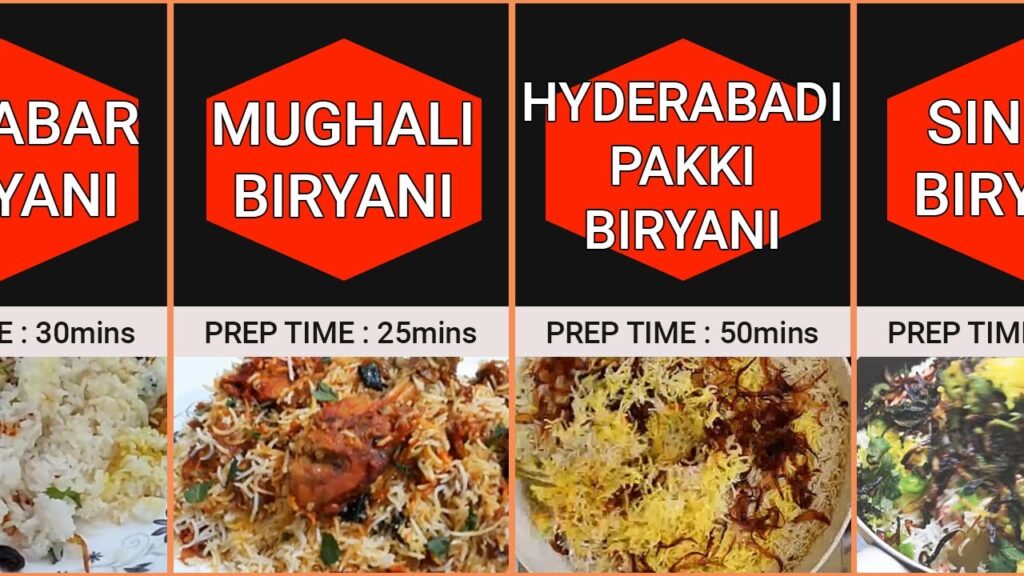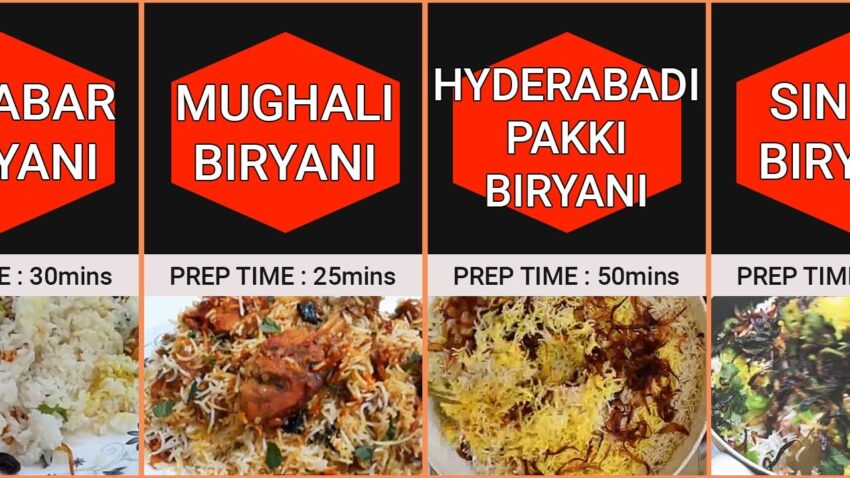
Biryani Varieties List: The Ultimate Guide to Regional Delights
Craving a flavorful journey through the world of biryani? You’ve come to the right place. Biryani, a symphony of rice, spices, and meat (or vegetables), is far from a monolithic dish. This article serves as your comprehensive guide to the astonishing diversity of biryani varieties, exploring regional specialties and uncovering the secrets behind each unique creation. We’ll delve into the ingredients, cooking methods, and cultural significance of various biryanis, ensuring you gain a deep appreciation for this beloved dish. Whether you’re a seasoned biryani connoisseur or a curious newcomer, this guide will expand your culinary horizons and inspire your next biryani adventure.
Understanding the Essence of Biryani: A Culinary Masterpiece
Before diving into the varieties, let’s understand what makes a biryani a biryani. At its core, biryani is a mixed rice dish originating from the Indian subcontinent. It’s characterized by the layering of pre-cooked rice with a flavorful meat (or vegetable) gravy, often called a *yakhni*. The dish is then slow-cooked, typically using the *dum pukht* method, where it’s sealed and cooked over low heat, allowing the flavors to meld and infuse the rice. The quality of the ingredients, the balance of spices, and the precision of the cooking process are crucial for a truly exceptional biryani.
The history of biryani is debated, but many believe it originated in Persia or Central Asia and was brought to India by the Mughals. Over time, the dish evolved, incorporating local ingredients and culinary techniques, resulting in the diverse range of biryani varieties we know today.
Key Elements of a Biryani:
- Rice: Traditionally, long-grain Basmati rice is preferred for its aroma and non-sticky texture.
- Meat/Vegetables: Chicken, mutton, beef, fish, prawns, and vegetables like potatoes, cauliflower, and paneer are commonly used.
- Spices: A blend of aromatic spices like cardamom, cinnamon, cloves, bay leaves, saffron, and nutmeg is essential.
- Yakhni (Gravy): The flavorful gravy, prepared with meat or vegetables and a blend of spices, is the heart of the biryani.
- Ghee/Oil: Ghee (clarified butter) or oil is used for cooking and adding richness to the biryani.
- Garnish: Fried onions, fresh herbs (coriander, mint), and nuts are used for garnish.
Regional Biryani Varieties: A Global Culinary Tour
The magic of biryani lies in its adaptability. Each region has put its unique spin on the dish, incorporating local ingredients, cooking styles, and flavor preferences. Here’s an extensive, but not exhaustive, list of some of the most popular and noteworthy biryani varieties:
Hyderabadi Biryani: The Royal Treat
Hailing from Hyderabad, India, Hyderabadi biryani is arguably the most famous variety. It’s characterized by its rich flavors, aromatic spices, and the use of *kacchi yakhni* (raw gravy). The meat and rice are layered and cooked together from a raw state, resulting in a deeply flavorful and tender biryani. Two main types exist: *Kacchi Gosht ki Biryani* (with raw meat) and *Dum Pukht Biryani* (slow-cooked). The addition of saffron and rose water adds a touch of royalty to this dish.
Lucknowi (Awadhi) Biryani: The Subtle Sophistication
Lucknowi biryani, also known as Awadhi biryani, is known for its subtle flavors and delicate aroma. The meat is marinated and cooked separately before being layered with rice and slow-cooked using the *dum pukht* method. The use of aromatic spices like cardamom, cloves, and kewra water gives it a distinct fragrance. It’s considered lighter and more refined than Hyderabadi biryani.
Kolkata Biryani: The Potato Surprise
Kolkata biryani is a variation of the Lucknowi style, but with a unique twist: the addition of potatoes. The potatoes are cooked with the meat and rice, absorbing the flavors and adding a creamy texture to the dish. The use of a sweet *meetha attar* (fragrant essence) also distinguishes it from other biryanis. The slightly sweet and savory flavor profile makes it a favorite among many.
Malabar Biryani: The Coastal Delight
From the Malabar region of Kerala, India, Malabar biryani is characterized by its use of short-grain *Kaima* rice and a blend of local spices. It often includes seafood, particularly prawns and fish, reflecting the coastal influence. The flavors are bold and spicy, with a hint of coconut milk in some variations. The use of fresh herbs and spices makes it a vibrant and flavorful dish.
Dindigul Biryani: The Spicy South Indian Sensation
Dindigul biryani, from Tamil Nadu, India, is known for its spicy and tangy flavor. It uses *seeraga samba* rice, a short-grain aromatic rice, and a generous amount of chili powder. The meat is cooked with a blend of spices and yogurt, giving it a tangy and spicy flavor. It’s a popular street food in Tamil Nadu and is known for its fiery kick.
Bombay Biryani: The Sweet and Savory Fusion
Bombay biryani is a fusion of flavors, incorporating elements from different regional styles. It often includes dried plums (aloo bukhara), potatoes, and kewra water, adding a sweet and savory dimension to the dish. The use of fried onions and nuts adds a crunchy texture. It’s a flavorful and aromatic biryani that reflects the cosmopolitan nature of Mumbai.
Sindhi Biryani: The Tangy Pakistani Specialty
Sindhi biryani, from the Sindh province of Pakistan, is known for its tangy and spicy flavor. It uses a generous amount of green chilies, yogurt, and dried plums, giving it a distinct taste. The addition of potatoes and fried onions adds texture and flavor. It’s a popular dish in Pakistan and is often served at weddings and celebrations.
Memoni Biryani: The Fiery Pakistani Delight
Memoni biryani, another Pakistani specialty, is known for its extremely spicy flavor. It uses a large amount of green chilies and other spices, making it one of the spiciest biryani varieties. It doesn’t typically use tomatoes or other ingredients that would add sweetness or tanginess. This biryani is not for the faint of heart!
Sri Lankan Biryani: The Island Twist
Sri Lankan biryani often incorporates unique spices and ingredients specific to the island nation. While influenced by Indian biryani styles, it often features a spicier profile and the use of ingredients like pandan leaves and lemongrass. The cooking style and rice type vary depending on the region within Sri Lanka.
Tehari: The Vegetarian Biryani Alternative
Tehari is a vegetarian version of biryani, popular in Uttar Pradesh, India. It’s made with potatoes, vegetables, and rice, cooked together with a blend of spices. It’s a flavorful and satisfying vegetarian alternative to meat-based biryanis. During Aurangzeb’s rule, when meat consumption was discouraged, Tehari became a popular dish among Hindus.
Other Notable Biryani Varieties:
- Beary Biryani: From the Beary Muslim community in Karnataka, India, this biryani is known for its unique blend of spices and the use of coconut milk.
- Ambur Biryani: From Tamil Nadu, this biryani is cooked over a wood fire and is known for its distinctive aroma and flavor.
- Kampong Biryani: A Malaysian take on the dish, often featuring chicken and local spices.
Spice Blends: The Secret to Biryani’s Flavor Profile
The spice blend is the heart and soul of any biryani. While the specific spices and their proportions vary depending on the region and the type of biryani, some common ingredients include:
- Cardamom: Adds a sweet and aromatic flavor.
- Cinnamon: Adds a warm and woody flavor.
- Cloves: Adds a pungent and aromatic flavor.
- Bay Leaves: Adds a subtle and earthy flavor.
- Saffron: Adds a delicate flavor and a vibrant yellow color.
- Nutmeg: Adds a warm and nutty flavor.
- Mace: Adds a delicate and aromatic flavor.
- Cumin: Adds a warm and earthy flavor.
- Coriander: Adds a fresh and citrusy flavor.
- Chili Powder: Adds heat and spice.
- Turmeric: Adds color and a slightly bitter flavor.
- Ginger-Garlic Paste: Adds a pungent and aromatic flavor.
Many commercial biryani spice blends are available, but for the best flavor, consider making your own blend using fresh, high-quality spices. Experiment with different combinations to find your perfect flavor profile.
The Art of Dum Pukht: Slow Cooking for Maximum Flavor
*Dum pukht* is a slow-cooking technique that is essential for many biryani varieties. It involves sealing the dish tightly with dough and cooking it over low heat for several hours. This allows the flavors to meld and infuse the rice, resulting in a deeply flavorful and aromatic biryani.
The *dum pukht* method also helps to retain moisture, keeping the rice soft and fluffy. The slow cooking process tenderizes the meat, making it melt-in-your-mouth delicious.
Biryani as a Culinary Experience: Beyond the Recipe
Biryani is more than just a dish; it’s a culinary experience. It’s a celebration of flavors, aromas, and textures. The preparation of biryani is often a labor of love, requiring time, patience, and attention to detail.
Serving biryani is also an art. It’s often served with raita (yogurt dip), salad, and papadums. The combination of flavors and textures creates a complete and satisfying meal.
Q&A: Your Biryani Questions Answered
- What is the difference between biryani and pulao?
Biryani involves layering pre-cooked rice and gravy, then slow-cooking. Pulao, on the other hand, involves cooking rice and meat/vegetables together in a single pot, often with the addition of whole spices.
- What type of rice is best for biryani?
Long-grain Basmati rice is generally considered the best for its aroma, non-sticky texture, and ability to absorb flavors.
- How do I prevent my biryani from becoming mushy?
Use the correct rice-to-water ratio, avoid overcooking, and allow the biryani to rest after cooking before serving.
- Can I make biryani in a pressure cooker?
Yes, but you need to be careful not to overcook it. Reduce the cooking time and water content accordingly. The *dum pukht* effect will be diminished.
- What are some vegetarian alternatives to meat in biryani?
Paneer (Indian cheese), vegetables like potatoes, cauliflower, and carrots, and mushrooms are all excellent choices.
- How can I make my biryani spicier?
Add more green chilies, red chili powder, or black pepper to the spice blend.
- How can I make my biryani more aromatic?
Use high-quality spices, add saffron and kewra water, and garnish with fresh herbs.
- What is the best way to reheat biryani?
Reheat it in a microwave or oven with a sprinkle of water to prevent it from drying out. Alternatively, steam it gently on the stovetop.
- Can I freeze biryani?
Yes, you can freeze biryani for up to 2-3 months. Thaw it completely before reheating.
- What are some common mistakes to avoid when making biryani?
Overcooking the rice, using too much water, not using enough spices, and not allowing the flavors to meld properly are all common mistakes.
Conclusion: Embark on Your Biryani Adventure
As you can see, the world of biryani is vast and varied, offering a delightful culinary adventure for every palate. From the royal Hyderabadi biryani to the spicy Dindigul biryani, each variety has its unique charm and flavor profile. We’ve explored the history, ingredients, and cooking techniques of various biryanis, equipping you with the knowledge to appreciate and recreate these culinary masterpieces. So, go ahead, explore the *biryani varieties list*, experiment with different recipes, and discover your favorite biryani. Share your experiences with biryani varieties in the comments below! Happy cooking!

